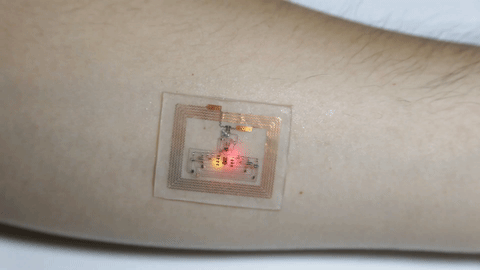
Image: Kim et al.
A team of researchers recently developed a next-generation medical wearable that will make your Fitbit look archaic.
A new study details the development of a small, stretchy sensor that monitors heart rate, blood oxygen levels, and UV radiation exposure – all without batteries or wires.
The patch, which relies on wirelessly transmitted power, uses near-field communication to activate LED lights. Essentially, the energy to power the device is harnessed from wasted energy emitted from surrounding electronics such as smartphones or tablets. The lights then penetrate the skin and reflect back to the sensor, transmitting data to a nearby device. In this application, radio frequencies are used to both transmit communications and provide an energy source.
Without the need for a battery, researchers were able to create an ultra-thin sensor.
This from Popular Science:
The LEDs can be programmed to flash in sync with a pulse, and infrared-spectrum lights can correlate to blood oxygen levels or signal changes in skin color. It picks up UV radiation levels through an embedded UV-sensitive material that detects how light scatters and absorbs into the skin.
The size, efficiency, and medical depth of the sensor could be a game changing technology in wearables.


